Refractive Indices of Glasses
Scott Prahl
Sept 2023
The interface is a bit weird. Basically, you need to get the Sellmeier coefficients for the type of glass that you want. Fortunately, this module has a bunch of glasses entered already. The list is named ALL_GLASS_NAMES.
[1]:
# Jupyterlite support for ofiber
try:
import micropip
await micropip.install("ofiber")
except ModuleNotFoundError:
pass
import matplotlib.pyplot as plt
import numpy as np
import ofiber
%config InlineBackend.figure_format='retina'
[2]:
print(ofiber.ALL_GLASS_NAMES)
['SiO2' 'GeO2' '9.1% P2O2' '13.3% B2O3' '1.0% F' '16.9% Na2O : 32.5% B2O3'
'ABCY' 'HBL' 'ZBG' 'ZBLA' 'ZBLAN' '5.2% B2O3' '10.5% P2O2' 'N-BK7'
'fused silica' 'sapphire (ordinary)' 'sapphire (extraordinary)'
'MgF2 (ordinary)' 'MgF2 (extraordinary)' 'CaF2' 'F2' 'F5' 'FK5HTi' 'K10'
'K7' 'LAFN7' 'LASF35' 'LF5' 'LF5HTi' 'LLF1' 'LLF1HT' 'N-BAF1' 'N-BAF4'
'N-BAF5' 'N-BAF5' 'N-BAK1' 'N-BAK2' 'N-BAK4' 'N-BALF' 'N-BALF' 'N-BASF'
'N-BASF' 'N-BK10' 'N-F2' 'N-FK5' 'N-FK51' 'N-FK58' 'N-K5' 'N-KF9'
'N-KZFS' 'N-KZFS' 'N-KZFS' 'N-KZFS' 'N-KZFS' 'N-LAF2' 'N-LAF2' 'N-LAF3'
'N-LAF3' 'N-LAF3' 'N-LAF7' 'N-LAK1' 'N-LAK1' 'N-LAK1' 'N-LAK2' 'N-LAK2'
'N-LAK3' 'N-LAK3' 'N-LAK7' 'N-LAK8' 'N-LAK9' 'N-LASF' 'N-LASF' 'N-LASF'
'N-LASF' 'N-LASF' 'N-LASF' 'N-LASF' 'N-LASF' 'N-LASF' 'N-PK51' 'N-PK52'
'N-PSK3' 'N-PSK5' 'N-SF1' 'N-SF10' 'N-SF11' 'N-SF14' 'N-SF15' 'N-SF2'
'N-SF4' 'N-SF5' 'N-SF57' 'N-SF6' 'N-SF66' 'N-SF6H' 'N-SF8' 'N-SK11'
'N-SK14' 'N-SK16' 'N-SK2' 'N-SK4' 'N-SK5' 'N-SSK2' 'N-SSK5' 'N-SSK8'
'N-ZK7' 'N-ZK7A' 'P-BK7' 'P-LAF3' 'P-LAK3' 'P-LASF' 'P-LASF' 'P-LASF'
'P-SF68' 'P-SF69' 'P-SF8' 'P-SK57' 'P-SK57' 'P-SK58' 'P-SK60' 'SF1'
'SF10' 'SF11' 'SF2' 'SF4' 'SF5' 'SF56A' 'SF57']
You can just count to find the glass you want. Standard silicon dioxide SiO₂ has number 0. Germanium dioxide GeO₂ has number 1.
Alternatively you can search for the glass you want. The number of BK7 is 13.
[3]:
ofiber.find_glass("BK7")
[3]:
13
So ofiber.glass(13) will return the coefficients for BK7 glass for example. The function ofiber.n(glass,λ) returns the index of refraction at a particular (vacuum) wavelength \(\lambda_0\).
[4]:
glass_coefficients = ofiber.glass(13)
name = ofiber.glass_name(13)
λ = np.linspace(1000,1700,100)*1e-9
n = ofiber.n(glass_coefficients,λ)
plt.plot(λ*1e9,n)
plt.title(name)
plt.xlabel('Wavelength (nm)')
plt.ylabel('Index of Refraction')
plt.show()
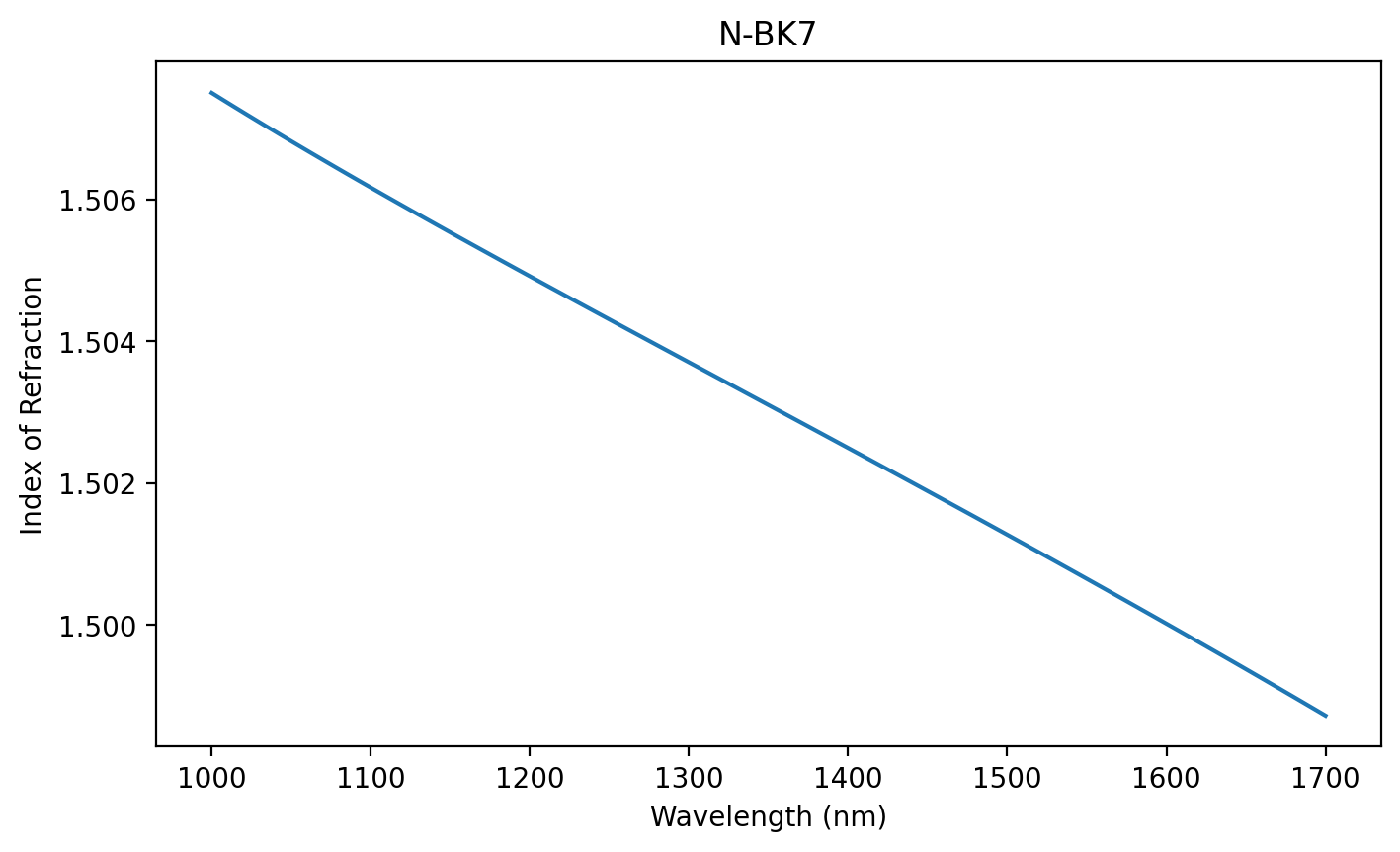
SiO₂ and GeO₂ fibers
These are the mainstay of the optical fiber industry. By doping SiO₂ with GeO₂ different refractive index profiles can be achieved. This plot shows the limits of 100% of each material. They look pretty similar, just displaced by 0.14 index units.
[5]:
glass = ofiber.glass(0)
name = ofiber.glass_name(0)
λ = np.linspace(1000,1700,100)*1e-9
n = ofiber.n(glass,λ)
plt.plot(λ*1e9,n,label=name)
glass = ofiber.glass(1)
name = ofiber.glass_name(1)
λ = np.linspace(1000,1700,100)*1e-9
n = ofiber.n(glass,λ)
plt.plot(λ*1e9,n,label=name)
plt.title("SiO₂ and GeO₂ ")
plt.xlabel('Wavelength (nm)')
plt.ylabel('$n(\lambda)$ [1/micron]')
plt.legend()
plt.show()
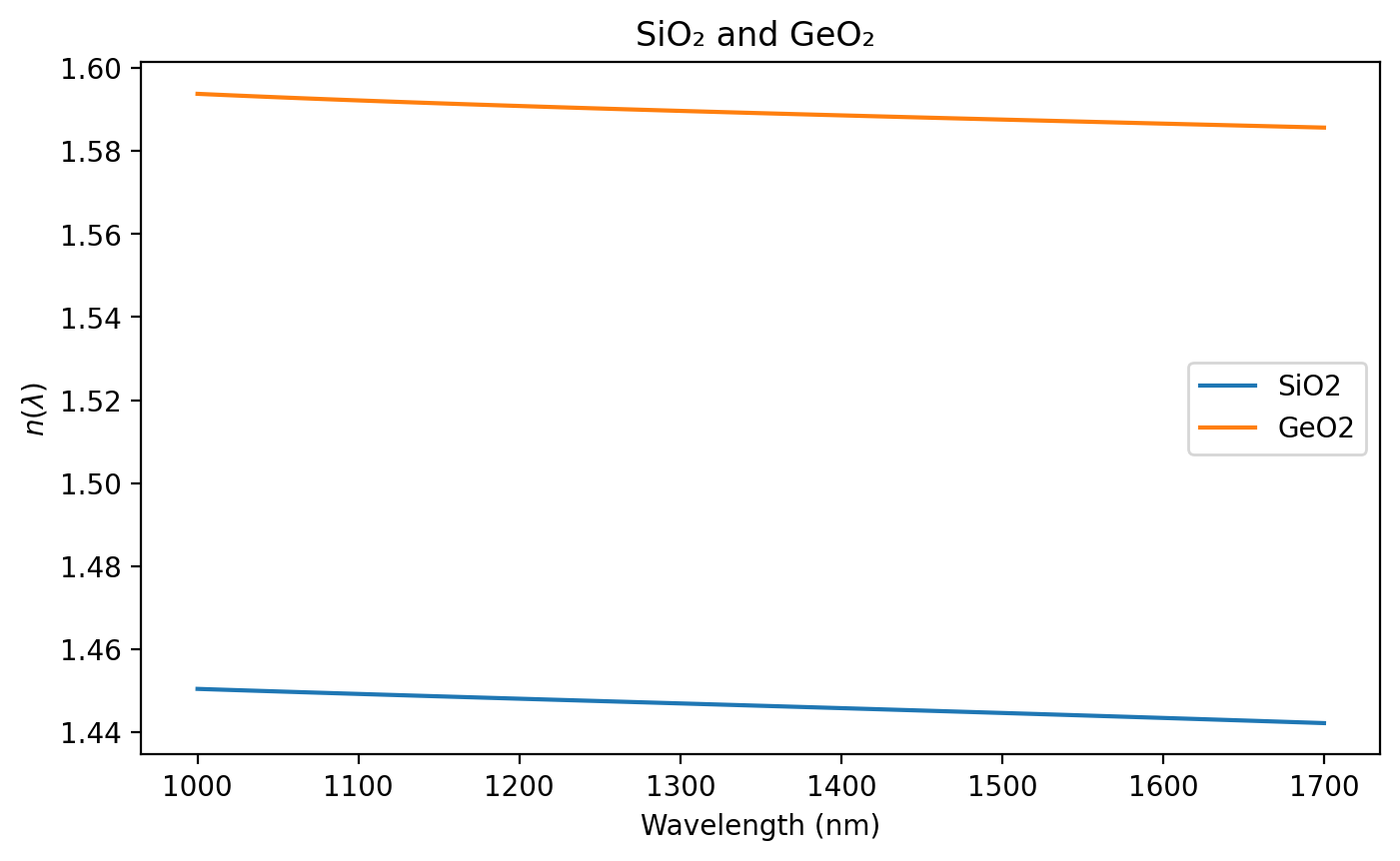
However, if you plot the first derivative, interesting things appear. Notice the weird units on the vertical axis.
[6]:
glass = ofiber.glass(0)
name = ofiber.glass_name(0)
λ = np.linspace(1000,1700,100)*1e-9
dn = ofiber.dn(glass,λ)
plt.plot(λ*1e9,dn*1e-6,label=name)
glass = ofiber.glass(1)
name = ofiber.glass_name(1)
λ = np.linspace(1000,1700,100)*1e-9
dn = ofiber.dn(glass,λ)
plt.plot(λ*1e9,dn*1e-6,label=name)
plt.title("SiO₂ and GeO₂ ")
plt.xlabel('Wavelength (nm)')
plt.ylabel('dn/d$\lambda$ [1/micron]')
plt.legend()
plt.show()
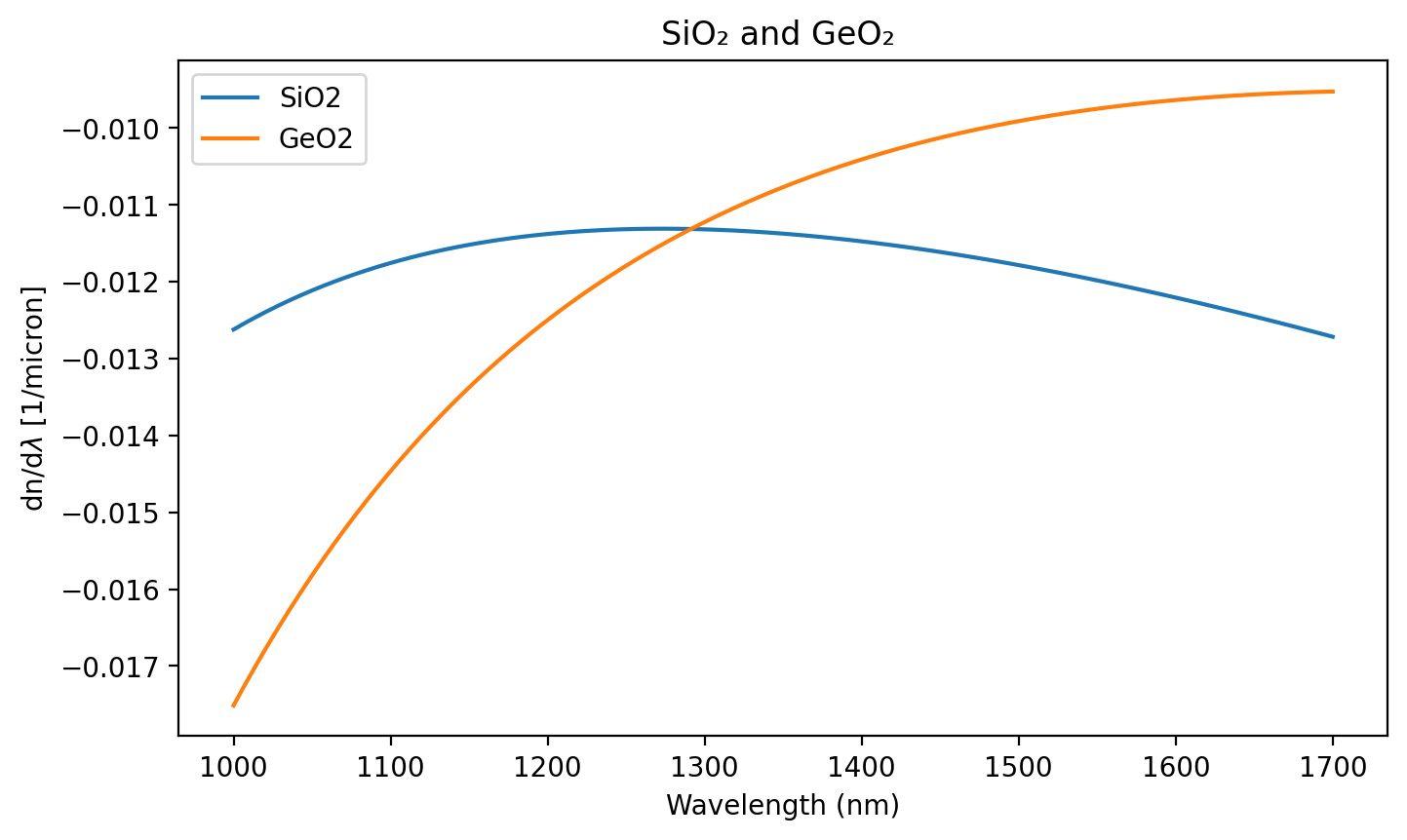
SiO₂ doped with GeO₂
Since doping of SiO₂ with GeO₂ is common there is a special routine to generate Sellmeier coefficients for glass doped with a specific fraction \(x\) of GeO₂. The interface is simple.
[7]:
help(ofiber.doped_glass)
Help on function doped_glass in module ofiber.refraction:
doped_glass(x)
Calculate Sellmeier coefficients for SiO_2 doped with GeO_2.
The idea is that the glass a combination of silicon dioxide or
germanium dioxide where x is the molar fraction of GeO_2. Thus
(1-x) is the molar fraction of SiO_2. The overall composition is
x * GeO_2 : (1 - x) * SiO_2.
Args:
x: fraction of GeO_2 (0<=x<=1)
Returns:
Sellmeier coefficients for doped glass (array of six values)
Here the second derivative of the refractive index is plotted for 100% SiO₂, 100% GeO₂, and 10% GeO₂
[8]:
glass = ofiber.glass(0)
name = ofiber.glass_name(0)
λ = np.linspace(1000,1700,100)*1e-9
d2n = ofiber.d2n(glass,λ)
plt.plot(λ*1e9,d2n*1e-12,label=name)
glass = ofiber.glass(1)
name = ofiber.glass_name(1)
λ = np.linspace(1000,1700,100)*1e-9
d2n = ofiber.d2n(glass,λ)
plt.plot(λ*1e9,d2n*1e-12,label=name)
glass = ofiber.doped_glass(0.10)
name = ofiber.doped_glass_name(0.1)
λ = np.linspace(1000,1700,100)*1e-9
d2n = ofiber.d2n(glass,λ)
plt.plot(λ*1e9,d2n*1e-12,label=name)
plt.plot([1000,1700],[0,0],':k')
plt.title("sio2 and geo2")
plt.xlabel('Wavelength (nm)')
plt.ylabel('$d^2n/d\lambda^2$ [1/$\mu$m$^2$]')
plt.legend()
plt.show()
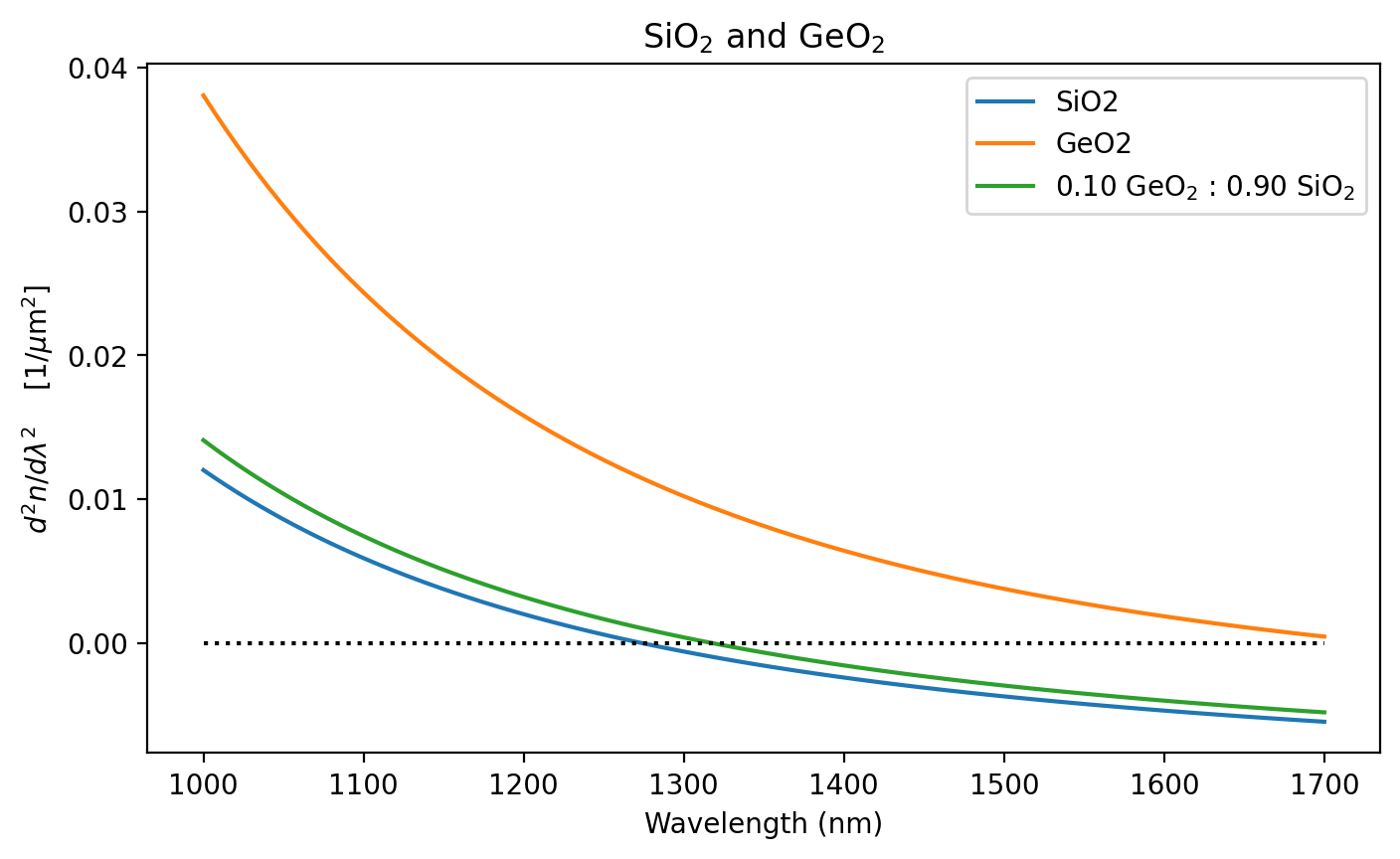
If we just want the second derivative at a specific wavelength, that is simple too. The only tricky part is converting from the default 1/m\(^2\) to 1/µm\(^2\)
[9]:
λ = 1550e-9
glass=ofiber.glass(0)
name=ofiber.glass_name(0)
disp = ofiber.d2n(glass,λ)
print('d^2n/dlambda^2 of %s at %.0f nm is %.4f/um**2'%(name,λ*1e9,disp*1e-12))
d^2n/dlambda^2 of SiO2 at 1550 nm is -0.0042/um**2
We can calculate use this to calculate the material, waveguide, and total dispersion for a fiber. (These are available directly in the ofiber.dispersion module. This is just an example.)
[10]:
# Ghatak Section 3.A.1, page 85.
#
c = 3e8 # [m/s]
a = 4.1e-6 # [m] Fiber radius
delta = 0.0025 # Fractional change in the index of refraction
start = 1100
finish = 1700
resolution = 10
λ = np.arange(start,finish,resolution)*1e-9
npoints = len(λ)
glass=ofiber.glass(0)
n1 = ofiber.n(glass,λ)
d2n = ofiber.d2n(glass,λ)
V = (2*np.pi/λ)*a*n1*np.sqrt(2*delta)
# Material Dispersion
M = -(λ/c)*d2n
# Waveguide dispersion
Dw = -n1*(1+delta)*delta/c/λ*(0.080+0.549*(2.834-V)**2)
ps_nm_km = 1e-12/1e-9/1e3
plt.subplots(1,1, figsize=(8,6))
plt.plot(λ*1e9,M/ps_nm_km,color='blue')
plt.plot(λ*1e9,Dw/ps_nm_km,color='orange')
plt.plot(λ*1e9,(M+Dw)/ps_nm_km,color='red')
plt.plot([1100,1700],[0,0],'k')
plt.xlabel('Wavelength [microns]')
plt.ylabel('Fiber Dispersion [ps/km/nm]')
plt.title('Core=13.5GeO₂:85.5SiO₂, Diameter=%.1f$\mu$m, Δ=%.4f'%(a*2e6,delta))
plt.xlim(1100,1700)
plt.annotate('Total Dispersion', xy=(1420,5),color='red')
plt.annotate('Material Dispersion', xy=(1300,18),color='blue')
plt.annotate('Waveguide Dispersion', xy=(1400,-10),color='orange')
plt.show()
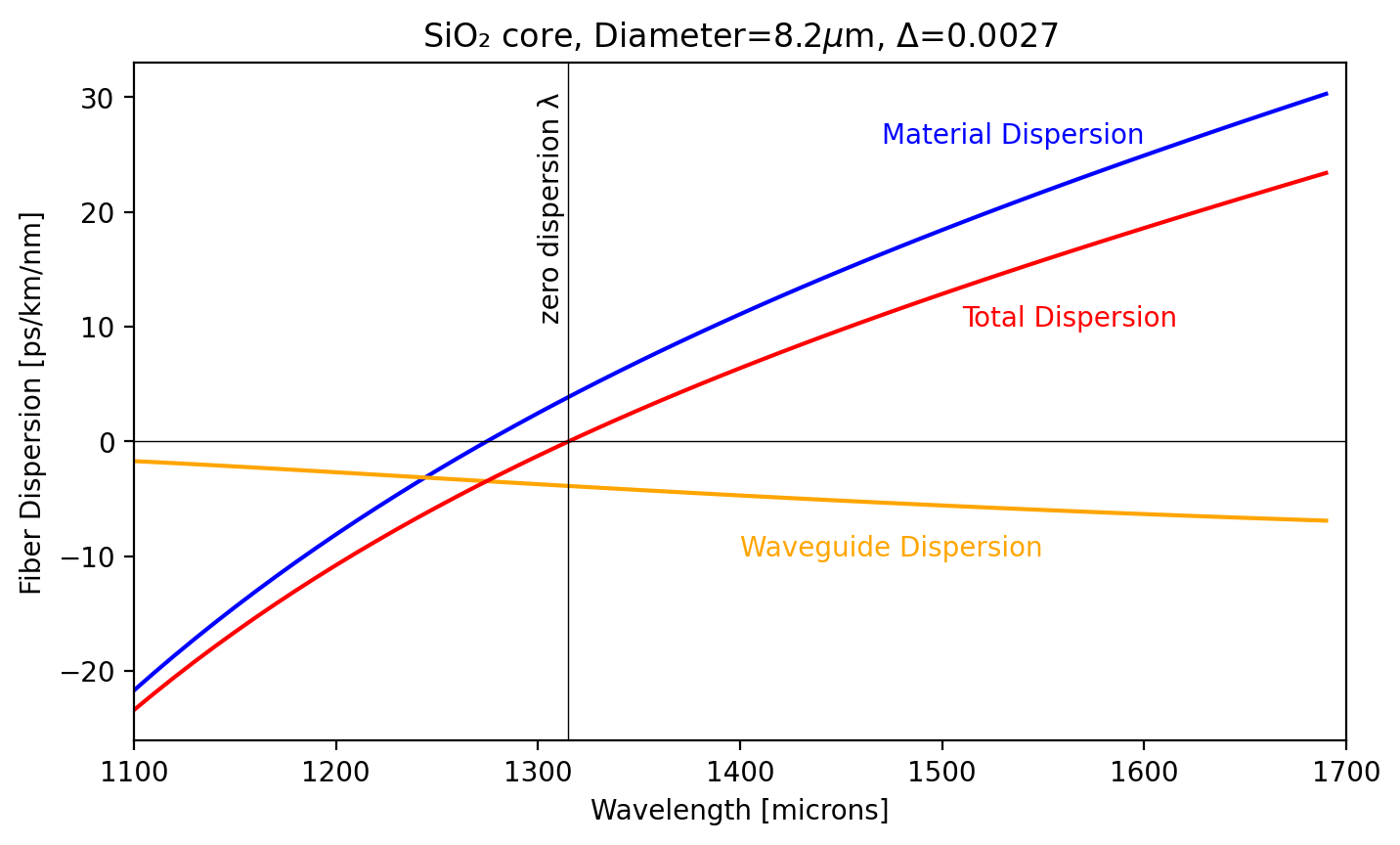
[ ]: